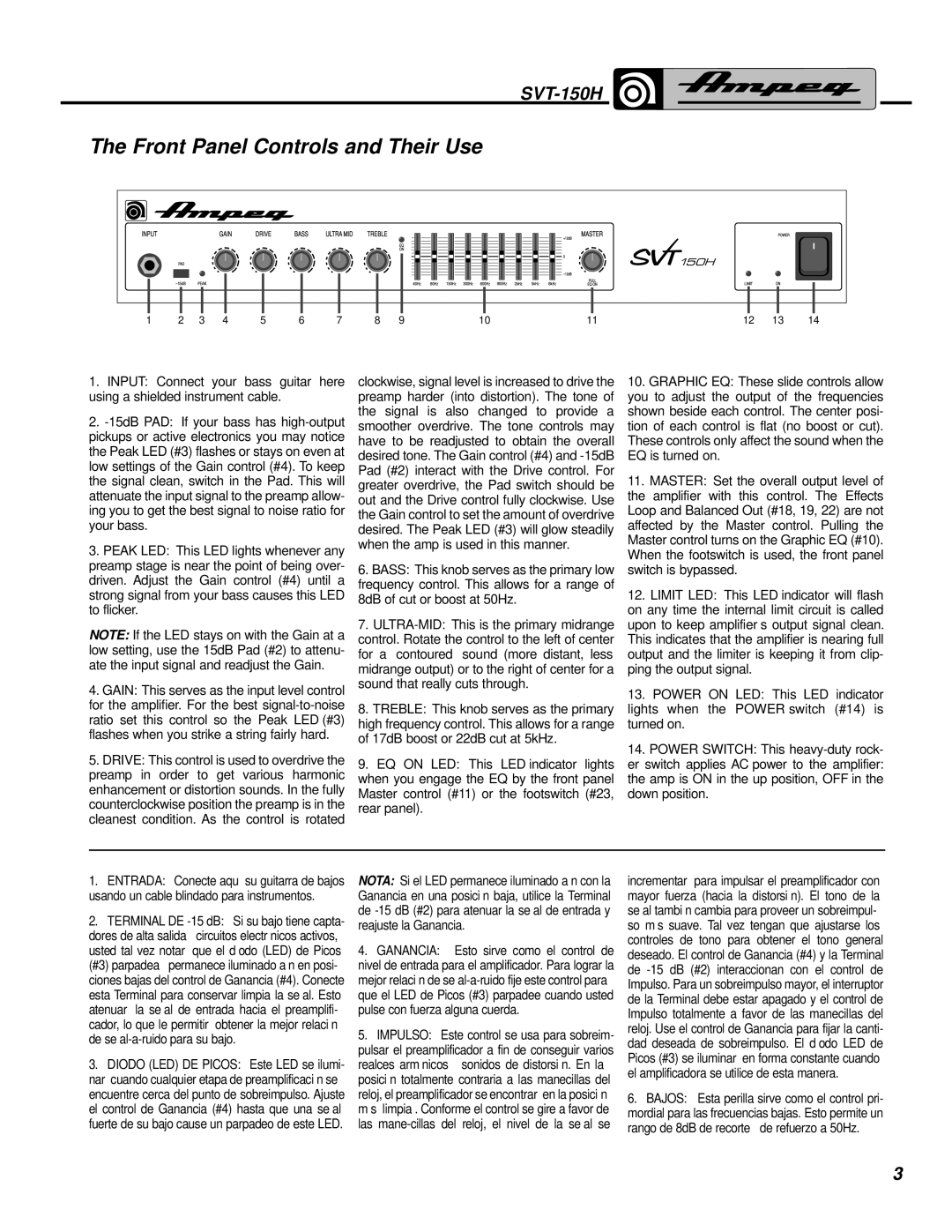
SVT-150H
The Front Panel Controls and Their Use
1 | 2 | 3 | 4 | 5 | 6 | 7 | 8 | 9 | 10 | 11 | 12 | 13 | 14 |
1.INPUT: Connect your bass guitar here using a shielded instrument cable.
2.
3.PEAK LED: This LED lights whenever any preamp stage is near the point of being over- driven. Adjust the Gain control (#4) until a strong signal from your bass causes this LED to flicker.
NOTE: If the LED stays on with the Gain at a low setting, use the 15dB Pad (#2) to attenu- ate the input signal and readjust the Gain.
4.GAIN: This serves as the input level control for the amplifier. For the best
5.DRIVE: This control is used to overdrive the preamp in order to get various harmonic enhancement or distortion sounds. In the fully counterclockwise position the preamp is in the cleanest condition. As the control is rotated
clockwise, signal level is increased to drive the | 10. GRAPHIC EQ: These slide controls allow | |
preamp harder (into distortion). The tone of | you to adjust the output of the frequencies | |
the signal is also changed to provide a | shown beside each control. The center posi- | |
smoother overdrive. The tone controls may | tion of each control is flat (no boost or cut). | |
have to be readjusted to obtain the overall | These controls only affect the sound when the | |
desired tone. The Gain control (#4) and | EQ is turned on. | |
Pad (#2) interact with the Drive control. For | 11. MASTER: Set the overall output level of | |
greater overdrive, the Pad switch should be | ||
the amplifier with this control. The Effects | ||
out and the Drive control fully clockwise. Use | ||
Loop and Balanced Out (#18, 19, 22) are not | ||
the Gain control to set the amount of overdrive | ||
affected by the Master control. Pulling the | ||
desired. The Peak LED (#3) will glow steadily | ||
Master control turns on the Graphic EQ (#10). | ||
when the amp is used in this manner. | ||
When the footswitch is used, the front panel | ||
6. BASS: This knob serves as the primary low | ||
switch is bypassed. | ||
frequency control. This allows for a range of | 12. LIMIT LED: This LED indicator will flash | |
8dB of cut or boost at 50Hz. | ||
on any time the internal limit circuit is called | ||
7. | ||
upon to keep amplifier’s output signal clean. | ||
control. Rotate the control to the left of center | This indicates that the amplifier is nearing full |
for a “contoured” sound (more distant, less output and the limiter is keeping it from clip-
midrange output) or to the right of center for a | ping the output signal. | |
sound that really cuts through. | 13. POWER ON LED: This LED indicator | |
8. TREBLE: This knob serves as the primary | ||
lights when the POWER switch (#14) is | ||
high frequency control. This allows for a range | turned on. | |
of 17dB boost or 22dB cut at 5kHz. | 14. POWER SWITCH: This | |
9. EQ ON LED: This LED indicator lights | ||
er switch applies AC power to the amplifier: | ||
when you engage the EQ by the front panel | the amp is ON in the up position, OFF in the | |
Master control (#11) or the footswitch (#23, | down position. | |
rear panel). |
|
1.ENTRADA: Conecte aquí su guitarra de bajos usando un cable blindado para instrumentos.
2.TERMINAL DE
3.DIODO (LED) DE PICOS: Este LED se ilumi- nará cuando cualquier etapa de preamplificación se encuentre cerca del punto de sobreimpulso. Ajuste el control de Ganancia (#4) hasta que una señal fuerte de su bajo cause un parpadeo de este LED.
NOTA: Si el LED permanece iluminado aún con la | incrementará para impulsar el preamplificador con | |
Ganancia en una posición baja, utilice la Terminal | mayor fuerza (hacia la distorsión). El tono de la | |
de | señal también cambia para proveer un sobreimpul- | |
reajuste la Ganancia. | so más suave. Tal vez tengan que ajustarse los | |
4. GANANCIA: Esto sirve como el control de | controles de tono para obtener el tono general | |
deseado. El control de Ganancia (#4) y la Terminal | ||
nivel de entrada para el amplificador. Para lograr la | ||
de | ||
mejor relación de | ||
Impulso. Para un sobreimpulso mayor, el interruptor | ||
que el LED de Picos (#3) parpadee cuando usted | ||
de la Terminal debe estar apagado y el control de | ||
pulse con fuerza alguna cuerda. | ||
Impulso totalmente a favor de las manecillas del | ||
| ||
5. IMPULSO: Este control se usa para sobreim- | reloj. Use el control de Ganancia para fijar la canti- | |
dad deseada de sobreimpulso. El díodo LED de | ||
pulsar el preamplificador a fin de conseguir varios | ||
Picos (#3) se iluminará en forma constante cuando | ||
realces armónicos ó sonidos de distorsión. En la | ||
el amplificadora se utilice de esta manera. | ||
posición totalmente contraria a las manecillas del | ||
| ||
reloj, el preamplificador se encontrará en la posición | 6. BAJOS: Esta perilla sirve como el control pri- | |
más “limpia”. Conforme el control se gire a favor de | mordial para las frecuencias bajas. Esto permite un | |
las | rango de 8dB de recorte ó de refuerzo a 50Hz. | |
|
3
